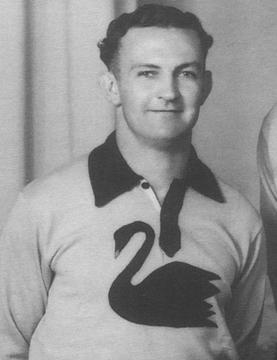Frederick "Fred" Williams (28 August 1919[1] – 3 April 2007) was an Australian rules football player and coach who played for the Subiaco Football Club in the Western Australian National Football League (WANFL) between 1938 and 1950, also coaching the club between 1948 and 1949. He also played representative football for Western Australia between 1946 and 1948.
| Fred Williams | |||
|---|---|---|---|
 | |||
| Personal information | |||
| Full name | Frederick Williams | ||
| Date of birth | 28 August 1919 | ||
| Date of death | 3 April 2007 (aged 87) | ||
| Original team(s) | West Subiaco (MFL) | ||
| Height | 175 cm (5 ft 9 in) | ||
| Weight | 78 kg (172 lb) | ||
| Position(s) | Utility | ||
| Playing career1 | |||
| Years | Club | Games (Goals) | |
| 1938–50 | ‹The template WAFL Sub is being considered for deletion.› Subiaco | 129 (unknown) | |
| Representative team honours | |||
| Years | Team | Games (Goals) | |
| 1946–48 | Western Australia | 4 (1) | |
| Coaching career | |||
| Years | Club | Games (W–L–D) | |
| 1948–49 | ‹The template WAFL Sub is being considered for deletion.› Subiaco | 37 (7–30–0) | |
|
1 Playing statistics correct to the end of 1950. | |||
| Career highlights | |||
| |||
| Source: AustralianFootball.com | |||
Career
Originally from the West Subiaco Football Club in the Metropolitan Football League (MFL), Williams made his debut for Subiaco in 1938. He left the club in June 1939 to train with the Geelong Football Club in the Victorian Football League (VFL),[2] however, the WANFL were unwilling to approve a transfer, despite Geelong's protests.[3] Williams returned to Subiaco for the 1940 season, which The Western Mail reported "created considerable interest, and came as a complete surprise to those 'not in the know'".[4] In 1941, Williams finished third in the Sandover Medal behind teammate Haydn Bunton and Ern Henfry of ‹See Tfd›Perth.[5]
At the conclusion of the 1941 season, Williams enlisted in the Australian Army. He served in New Guinea and New Britain during the war, and played in several army football teams, which included captaining a team which included Bernie Naylor and other senior footballers.[6] Williams returned to football in 1946, and was named captain, kicking 22 goals to be Subiaco's leading goalkicker,[7] as well as winning the club's best and fairest award, the President's Trophy.[8] He also represented Western Australia in three interstate matches during the season.[9] When not playing football, he worked as a meter reader for the Water Supply Department.[6] In 1948, Williams was appointed coach of Subiaco.[10] The club was generally unsuccessful during Williams' tenure as coach, losing over 80% of its games. He resigned as both captain and coach for the 1950 season, and announced his retirement at the end of the season, having "reached the stage where he preferred to make way for another man".[11]
In 2005, Williams was named Subiaco's "Club Legend" for the season, a WAFL initiative allowing "each club to honour a past champion by displaying their image and career details on the match ball for that particular season".[12] He died in April 2007 at the age of 87.[13] In 2008, Williams was named as an interchange player in Subiaco's Team of the Century.[14]
References
Wikiwand in your browser!
Seamless Wikipedia browsing. On steroids.
Every time you click a link to Wikipedia, Wiktionary or Wikiquote in your browser's search results, it will show the modern Wikiwand interface.
Wikiwand extension is a five stars, simple, with minimum permission required to keep your browsing private, safe and transparent.
